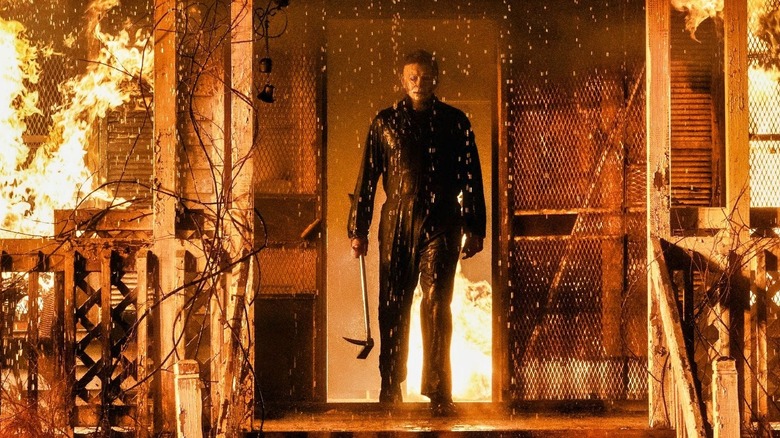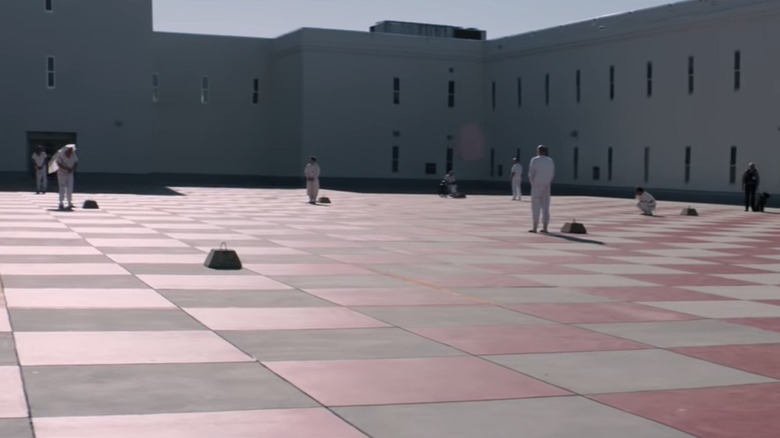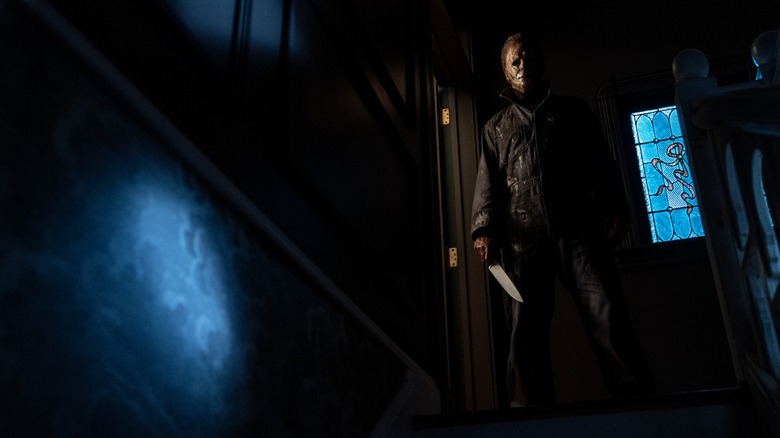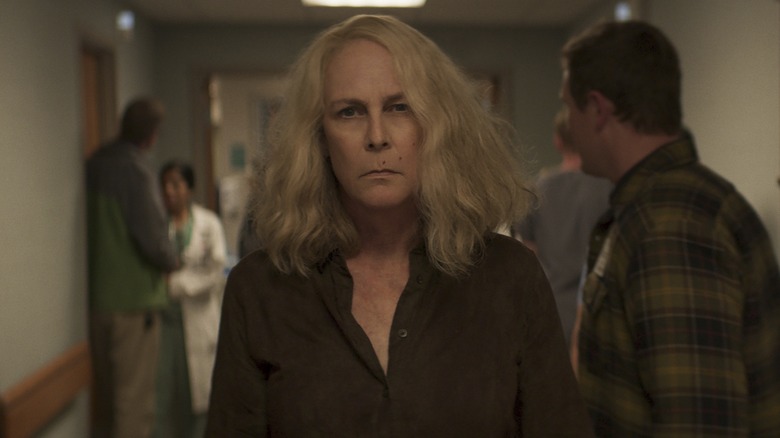How Halloween Kills Solved The Michael Myers Problem
Here's the thing: when you retcon an entire franchise down to two movies, you're gonna create some metatextual headaches. Such is the case in David Gordon Green's "Halloween," a direct sequel to John Carpenter's 1978 film of the same name. Despite being well-reviewed upon its initial release, Gordon's movie sits awkwardly at the intersection of a handful of ideas, resulting in a movie that tries to both ignore and borrow heavily from the sequels it's replacing.
And no matter how much Green wants his audience to buy into the notion of a decades-long Haddonfield trauma, the uneven conceptualization of Michael Myers highlights a real problem with the franchise going forward: how do you make a grounded movie about a supernatural killer? It's a question that takes two movies — both "Halloween" and "Halloween Kills" — to fully answer, and it's the reason why the latter film is a whole lot better (and a whole lot more necessary) than some critics would have you believe.
The Past Often Rhymes
To its credit, "Halloween" telegraphs its Michael Myers problem early on. In one scene shared by the film's teenage characters, Dave (Miles Robbins) hesitantly questions why Myers has such sway over the Strode family. "All things considered, there's a lot worse stuff that's happening today," he suggests. "And like, I mean, what, a couple of people getting killed by one guy with a knife is not that big of a deal."
Green plays the scene for humor — oh ho, look at this future victim foreshadowing his death at the hands of The Shape! — but it raises an important question about the nature of the film. Like most contemporary Hollywood sequels, "Halloween" is meant to both continue and restart a dormant film franchise. For most studios, this approach often means recycling the narrative beats of their predecessors with returning characters repositioned as the mentors they once followed. This can make these narratives feel off-kilter, caught between the desire to tell a unique story and the writerly challenge of giving a new generation their own version of a beloved classic.
This inherent contradiction is what makes "Halloween" such an uneven watch. While there are plenty of reasons to admire Green's trauma-heavy narrative — not least of which is Jamie Lee Curtis's nervy performance as a middle-aged Laurie Strode — the character choices often come into conflict with the structure itself. On paper, there's nothing wrong with using Strode as a next-generation Loomis; she too has looked evil in the eyes and taken it upon herself to prepare the world for its destruction. But whereas Loomis spent two straight decades with Myers, Strode has not seen her attacker for more than 40 years. Like so much of the movie, the connective tissue between Green and Carpenter are more echoes of ideas than ideas themselves.
And this leads us to the legacy of Myers on Haddonfield. For most of the film, Green and co-writer Danny McBride play a kind of canonical shell game with the audience, positioning their movie as a direct sequel to the first film when it suits them and playing off the mythology of the entire "Halloween" franchise when it doesn't. Myers has always been horror's reflection, an empty vessel on which to project industry and genre trends; here he is unmoored, caught half-formed between mortality and omnipotence. Is he the grim visage of death, still stalking Strode after all these years? Or the supernatural maniac who turns decapitated heads into jack-o-lanterns? The film can never quite decide.
And that's a big problem for a film positioned as a grounded continuation of the "Halloween" franchise. The film barters in a mythology that no longer exists; for Myers to hold an entire town in sway, we need grand acts of violence in-line with the exorcised sequels. In removing the bloat from the franchise, Green and company might have cut out much of what made The Shape an institution to begin with.
The Once and Future King
All of which brings us to "Halloween Kills." Green's latest entry in the "Halloween" franchise has taken its fair share of criticism; like many second films, it suffers a bit from middle-child syndrome and feels incomplete with the presumed closure of "Halloween Ends." But where "Halloween" is indecisive in its depiction of Myers, "Halloween Kills" is a grand ol' slasher through and through. From an opening dance of death with Haddonfield's fire department to a mob battle that combines the best instincts of Green as both an arthouse and genre filmmaker, here is the Myers we've been told to fear all along.
This is not to suggest that the more supernatural Myers of "Halloween Kills" is a better or more accurate version of the character; if the franchise has taught us anything, it's that Myers is often a direct reflection of the man behind the camera. Rather, "Halloween Kills" does a remarkable job of bringing its predecessor into focus. We can accept the Myers of "Halloween Kills" as the kind of murderous force that would inspire Laure Strode to turn her cabin into a programmable death trap. We also believe that the present-day Myers — if not the Myers of 1978 — would inspire the kind of religious mania that leads an entire town to take to the streets with baseball bats and guns.
Part of what makes "Halloween Kills" so fascinating is that we're watching Green build the Myers mythos in real-time, evolving him into the omnipresent killer that, at least according to in-world canon, the townsfolk have always know him to be. When Green adds this as a subtext to the movie — that Myers is only as strong as our collective fears allow him to be — the film finally reconciles the various versions of Myers from Green's first film into the horror icon that exists for audiences everywhere. Here is an entity who can stare motionless from a burning basement — and if Gordon is a little guilty of building the plane while he's flying it, well, that's what Jim Cummings and flashbacks are for.
Does that make "Halloween Kills" a good standalone movie? Maybe, maybe not — the angry mob subplot was handled far better in "Halloween 4: The Return of Michael Myers," and Green and McBride seem uncertain how each Strode family member should react following the events of the first film. But "Halloween Kills" is certainly a more consistent movie, one with a clear idea of what Michael Myers and his relationship to the town of Haddonfield should be. The creators are no longer grappling with the notion of what Myers could be in our world; from here on out, we're solidly in the hell that Myers himself has created.
Michael Myers and the Future
The final word on both movies will of course be "Halloween Ends," the third film in Green's proposed trilogy. But where some might see cause for concern, I see hope: "Halloween Kills" has resolved its metatextual issues and is presenting us with a version of Myers that fits both backwards and forwards. Those who like the grounded trauma of "Halloween" can put their faith in the multigenerational Strode storyline, those drawn to spectacle find themselves in a prime position for more violent chaos.
But whether Myers murders one man or a hundred, one thing remains true: Green's characters are no longer anchored to the world that Carpenter and Debra Hill created. For better or worse, this is the David Gordon Green "Halloween" franchise now, and his Michael Myers has earned the right to be whatever Green and company want him to be. And if it took a retcon, and a flashback, and a bit of present tense storytelling to make all the pieces fit together — well, what else would you expect from a franchise like 'Halloween'?



